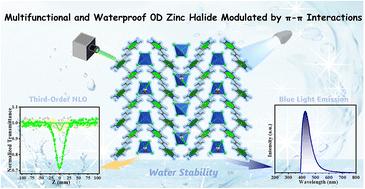当前位置:
X-MOL 学术
›
Inorg. Chem. Front.
›
论文详情
Our official English website, www.x-mol.net, welcomes your
feedback! (Note: you will need to create a separate account there.)
Water-stable zero-dimensional hybrid zinc halide modulated by π–π interactions: efficient blue light emission and third-order nonlinear optical response
Inorganic Chemistry Frontiers ( IF 6.1 ) Pub Date : 2024-10-22 , DOI: 10.1039/d4qi02194k Jia-Wei Li, Wenke Dong, Yanjie Liu, Yuhan Li, Lu-Yuan Qiao, Guang-Lu Liu, Hui Zhang, Chunjie Wang, Hui-Li Zheng, Jian-Qiang Zhao
Inorganic Chemistry Frontiers ( IF 6.1 ) Pub Date : 2024-10-22 , DOI: 10.1039/d4qi02194k Jia-Wei Li, Wenke Dong, Yanjie Liu, Yuhan Li, Lu-Yuan Qiao, Guang-Lu Liu, Hui Zhang, Chunjie Wang, Hui-Li Zheng, Jian-Qiang Zhao

|
Achieving multifunctional optimization of halide optical materials through the precise modulation of intermolecular interactions is highly significant, yet it faces considerable challenges. Here, we propose a strategy of π–π interactions microregulating to achieve the simultaneous optimization of multiple properties of halide optical materials. Using this strategy, we obtained a new lead-free zero-dimensional (0D) zinc halide [DPE]ZnCl4 (DPE = 1,2-di(4-pyridyl)ethylene), in which the protonated DPE cations are orderly arranged via π–π interactions, facilitating the ordered embedding and local regulation of [ZnCl4]2− units within long-range one-dimensional cationic π–π stacking. As a result of these modifications, [DPE]ZnCl4 exhibits efficient blue light emission with a high photoluminescent quantum yield (PLQY) of 18.55%, far exceeding that of corresponding organic salt halides. Furthermore, this compound demonstrates an enhanced third-order nonlinear optical (NLO) response, with the modulation depth and the third-order NLO absorption coefficient reaching 0.70 and 3.81 × 10−10 m W−1, respectively, surpassing those of three-dimensional (3D) perovskite quantum dots and most organic–inorganic hybrid halides. Notably, the modulation of π–π interactions results in a significant breakthrough in water resistance, allowing [DPE]ZnCl4 to maintain excellent structural and performance stability in water for a week. This innovative strategy of π–π interaction modulation provides new avenues for the multifunctional regulation and waterproof design of halide optical materials, and it is expected to advance the development and functionalization of stable halide optical materials.
中文翻译:

受 π-π 相互作用调制的水稳定零维杂化锌卤化物:高效的蓝光发射和三阶非线性光学响应
通过精确调节分子间相互作用实现卤化物光学材料的多功能优化非常重要,但也面临着相当大的挑战。在这里,我们提出了一种 π-π 相互作用微调节的策略,以实现卤化物光学材料的多种特性的同时优化。使用这种策略,我们获得了一种新的无铅零维 (0D) 卤化锌 [DPE]ZnCl4 (DPE = 1,2-二(4-吡啶基)乙烯),其中质子化的 DPE 阳离子通过 π-π 相互作用有序排列,促进了 [ZnCl4]2− 单元在长距离一维阳离子 π-π 堆叠中的有序嵌入和局部调节。由于这些修饰,[DPE]ZnCl4 表现出高效的蓝光发射,光致发光量子产率 (PLQY) 高达 18.55%,远高于相应的有机盐卤化物。此外,该化合物表现出增强的三阶非线性光学 (NLO) 响应,调制深度和三阶 NLO 吸收系数分别达到 0.70 和 3.81 × 10-10 m W-1,超过了三维 (3D) 钙钛矿量子点和大多数有机-无机杂化卤化物。值得注意的是,π-π 相互作用的调节导致耐水性的重大突破,使 [DPE]ZnCl4 能够在水中保持出色的结构和性能稳定性一周。 这种π-π相互作用调制的创新策略为卤化物光学材料的多功能调节和防水设计提供了新的途径,有望推动稳定卤化物光学材料的发展和功能化。
更新日期:2024-10-25
中文翻译:

受 π-π 相互作用调制的水稳定零维杂化锌卤化物:高效的蓝光发射和三阶非线性光学响应
通过精确调节分子间相互作用实现卤化物光学材料的多功能优化非常重要,但也面临着相当大的挑战。在这里,我们提出了一种 π-π 相互作用微调节的策略,以实现卤化物光学材料的多种特性的同时优化。使用这种策略,我们获得了一种新的无铅零维 (0D) 卤化锌 [DPE]ZnCl4 (DPE = 1,2-二(4-吡啶基)乙烯),其中质子化的 DPE 阳离子通过 π-π 相互作用有序排列,促进了 [ZnCl4]2− 单元在长距离一维阳离子 π-π 堆叠中的有序嵌入和局部调节。由于这些修饰,[DPE]ZnCl4 表现出高效的蓝光发射,光致发光量子产率 (PLQY) 高达 18.55%,远高于相应的有机盐卤化物。此外,该化合物表现出增强的三阶非线性光学 (NLO) 响应,调制深度和三阶 NLO 吸收系数分别达到 0.70 和 3.81 × 10-10 m W-1,超过了三维 (3D) 钙钛矿量子点和大多数有机-无机杂化卤化物。值得注意的是,π-π 相互作用的调节导致耐水性的重大突破,使 [DPE]ZnCl4 能够在水中保持出色的结构和性能稳定性一周。 这种π-π相互作用调制的创新策略为卤化物光学材料的多功能调节和防水设计提供了新的途径,有望推动稳定卤化物光学材料的发展和功能化。


















































 京公网安备 11010802027423号
京公网安备 11010802027423号